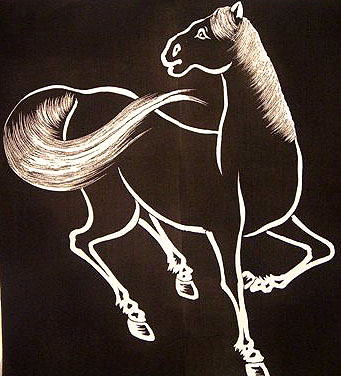

|
Japan Meiji Era (1868 - 1915), ca 1870s -1880s Natural dyes were used on a rare cr�pe like hand woven Chirimen Silk weave that has not been utilized by the Japanese since the 1800s, as the weaving |
 Detail: Large Sumie Horse The use of horses ("Uma") as the main motif on this stunning Nagajuban or Man's informal, under kimono demonstrates that it belonged to an individual of high social standing, as the general public was prohibited from riding or owning horses. Horses were limited to the upper class by the Tokugawa Shoguns, who prescribed exactly how they were to be used. It would become one�s heavenly duty to ride a horse when one visited a Shinto Shrine. In this same vein, horses were often given as a prayer offering to shrines. The wealthy gave meticulously groomed, and luxuriously and decoratively trapped horse as gifts, while the poorer gave paintings of horses on wood (�Ema�). These can still be seen as valued works of art at many shrines in Japan today, while the famous Nikko Shrine still maintains its white horses. A white or a black horse was most often used to lead the Shrine�s processions, and was believed to bring or end rainfall. By far, however, the greatest distinction of the horse was as the romantic symbol of the Samurai or Warrior who dominated Japanese society during the time of the Tokugawas. It was the Samurai who perfected the art of horse back riding combined with the sport of archery which continues at famous festivals to this day. Only natural dyes were used, while the actual hand woven Crepe-like, Chirimen Silk incorporated an extraordinary weaving process which was limited to the wealthy; and, whose technique has been lost to the Japanese for over 100 years. It has been hand painted using the Rice Paste Resist or "Tsutsugaki" method of painting on Silk. This process required that each color be applied separately, while all the others were painted out in the rice paste. Each time a new color was added, the rice paste had to be removed by soaking it out over and over again in the local river water and then reapplied. This technique required a great amount of skill by the artist as well as being extremely labor intensive. The ink or "Sumie" painting of the magnificent central horse indicates that the artisan who wove and painted this magnificent Kimono was extraordinarily skilled. It is obvious that this garment belonged to a man of high social standing and wealth as a Nagajuban was intended to be worn under another Kimono at home. An individual who could afford to hide such a magnificent Artwork was indeed blessed with abundance. Detail: Upper back of Kimono |
|
|